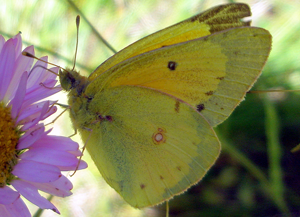The Orange Sulphur can vary in color from white, yellow to orange and some females can be pale greenish. Orange Sulphurs can hybridize with Clouded Sulphurs (Colias philodice ).
Photo Credit: johnvillela via flickr
Colias eurytheme
Common Name: orange sulphur
Other Common Names: alfalfa caterpillar, coliade de la luzerne
Animal Guild: Insect
Class > Order > Family: Insecta > Lepidoptera > Pieridae
What does the species look like?
This species can be quite variable. The upperside of males’ wings is yellow with orange, yellow veins, a wide black border, and a dark black spot. Females can be yellow, white or pale green with irregular black borders on their wings surrounding light spots. The underside of this species’ hindwing has a silver spot with two concentric rings, and a smaller spot above it.
Caterpillars are smooth and green with a white racing stripe down their length.
Total adult length: 1.4 to 1.7 inches (35.6 – 43.2 mm).
Similar species: The Southern Dogface is a similar looking species, but the forewing has the profile of a poodle in yellow with a black eye (dog’s snout facing away from the butterfly’s body). Further, the Southern Dogface has spot in the hindwing, but the spot does not have concentric rings as it does in the Orange Sulphur.
Where is the species found?
States & Provinces
AB, AL, AR, AZ, BC, CA, CO, CT, DC, DE, FL, GA, IA, ID, IL, IN, KS, KY, LA, MA, MB, MD, ME, MI, MN, MO, MS, MT, NB, NC, ND, NE, NH, NJ, NL, NM, NV, NY, OH, OK, ON, OR, PA, QC, RI, SC, SD, SK, TN, TX, UT, VA, VT, WA, WI, WV, WY
Distribution
This species is distributed through the southwest and occurs across most of the United States, and through the prairie provinces to Newfoundland in Canada.
General Phenology and Life History
Orange Sulphurs feed on alfalfa, clover and other legumes as caterpillars. Enormous numbers of these butterflies can occur in alfalfa fields – their favorite food as caterpillars.
They are actively flying from February to November in the high country, year-round in the deserts as adults.
Which phenophases should I observe?
Do you see/hear...?
Activity
Adults More...
For abundance, enter the number of individual animals observed in this phenophase.
Adults feeding Colias eurytheme , adults feed on the flower nectar of many different plant species.
For abundance, enter the number of individual animals observed in this phenophase.
Flower visitation For abundance, enter the number of individual animals observed in this phenophase.
Reproduction
Mating For abundance, enter the number of individual animals observed in this phenophase.
Egg laying Colias eurytheme , eggs are typically deposited on the leaves of alfalfa, clover or other plants in the pea family (Fabaceae).
For abundance, enter the number of individual animals observed in this phenophase.
Eggs Colias eurytheme , the tiny, ribbed, spindle-shaped eggs are initially white, becoming red as they develop, and are typically found on the leaves of alfalfa, clover or other plants in the pea family (Fabaceae).
For abundance, enter the number of individual animals observed in this phenophase.
Development
Caterpillars Colias eurytheme , caterpillars are green and develop a prominent lateral white stripe along each side as they get older.
For abundance, enter the number of individual animals observed in this phenophase.
Caterpillars feeding Colias eurytheme , caterpillars typically feed on alfalfa, clover or other plants in the pea family (Fabaceae).
For abundance, enter the number of individual animals observed in this phenophase.
Pupae Colias eurytheme , pupae are enclosed in a green, translucent shell (chrysalis) that appears yellowish with orange and black markings as the butterfly develops, and hang from plants or other outdoor surfaces. Do not include empty pupal shells after the adult has emerged from them.
For abundance, enter the number of individual animals observed in this phenophase.
Dead adults For abundance, enter the number of individual animals observed in this phenophase.
Dead caterpillars For abundance, enter the number of individual animals observed in this phenophase.
Method
Individuals at a feeding station For abundance, enter the number of individual animals observed in this phenophase.
Individuals in a net For abundance, enter the number of individual animals observed in this phenophase.
Individuals in a trap For abundance, enter the number of individual animals observed in this phenophase.
What do these phenophases look like?
There is currently no photoguide available for this species. If you'd like help us create one, use the guidance document and species template provided here . Then send it via email to education@usanpn.org when it is complete.
